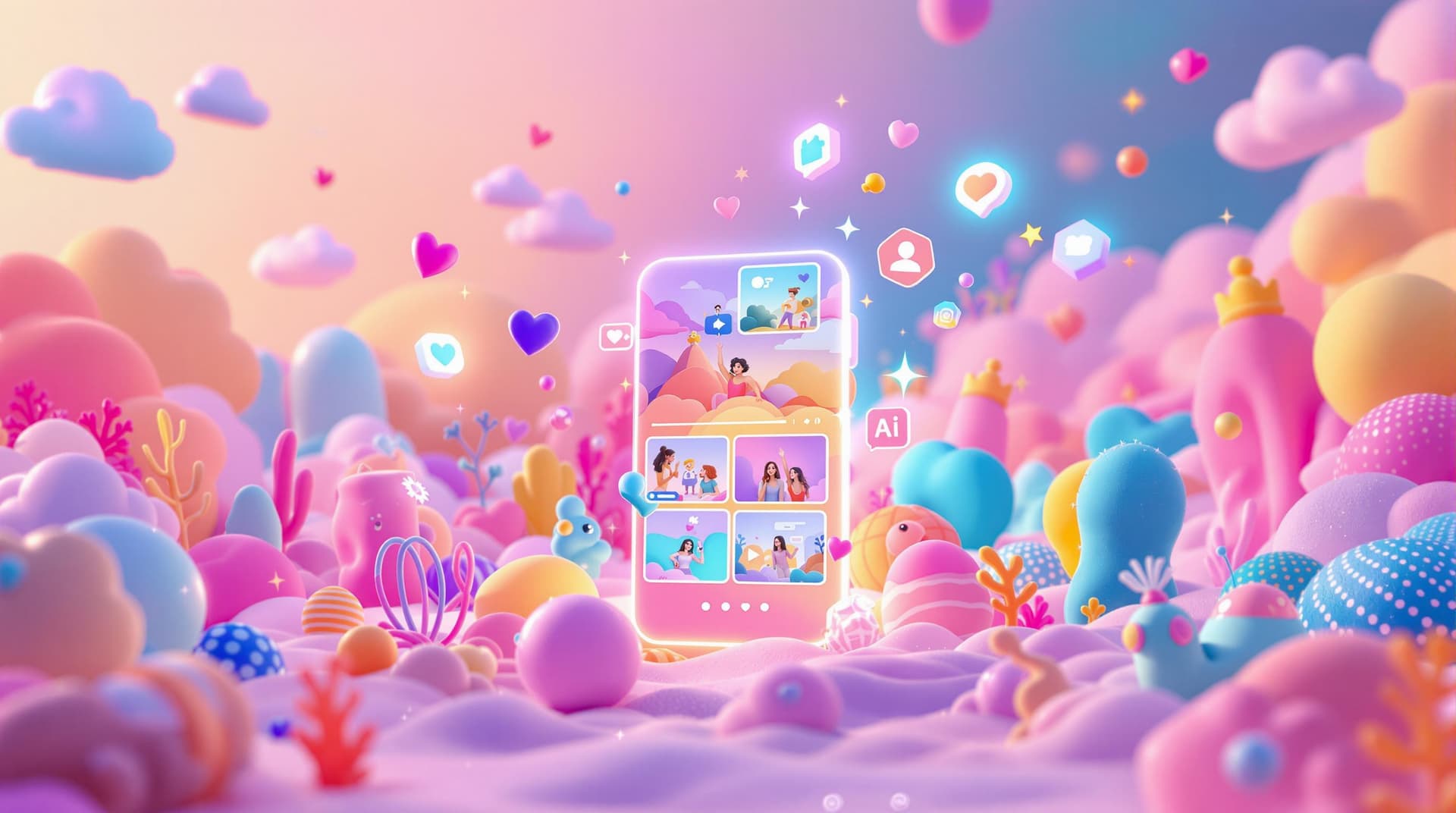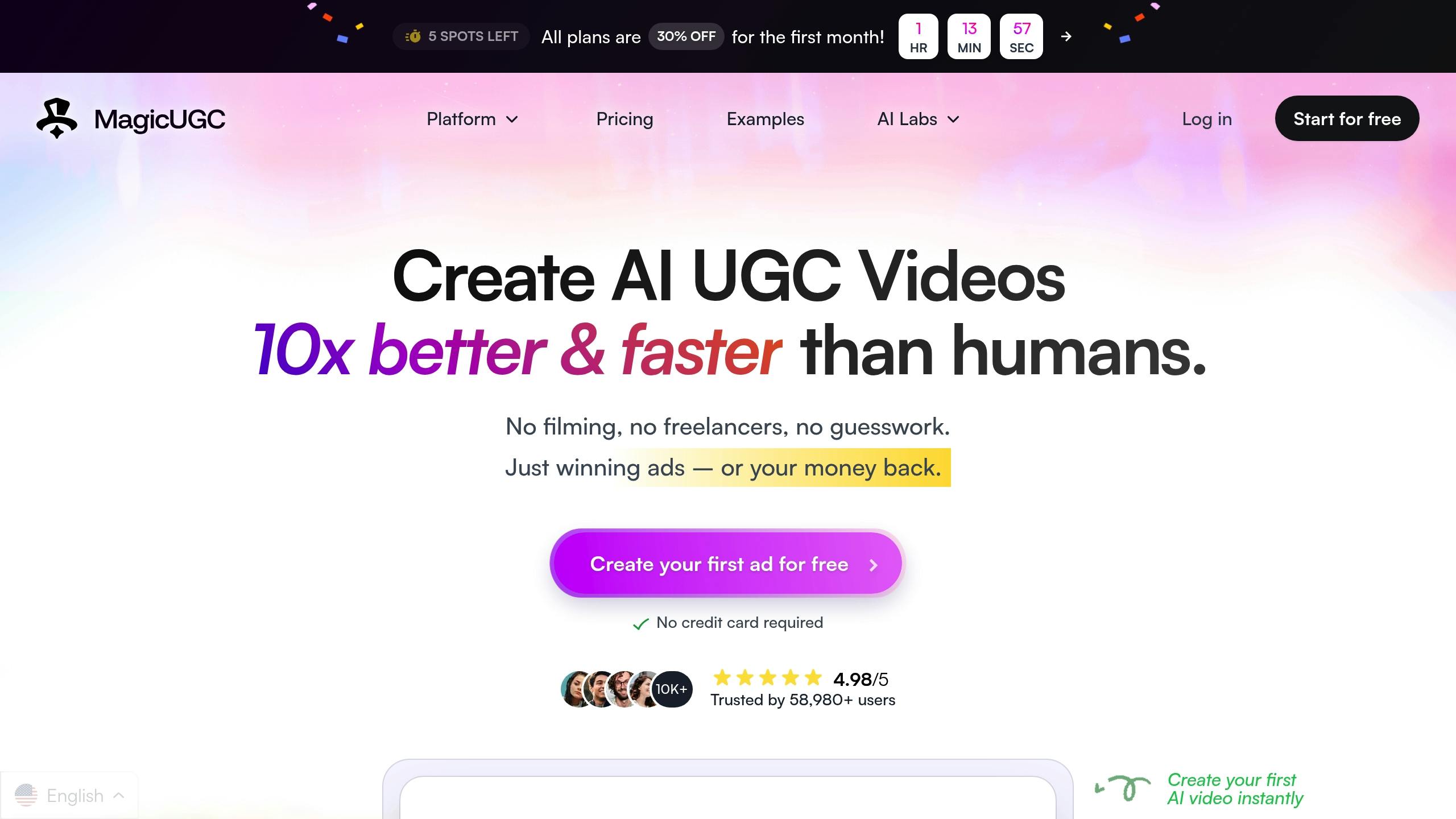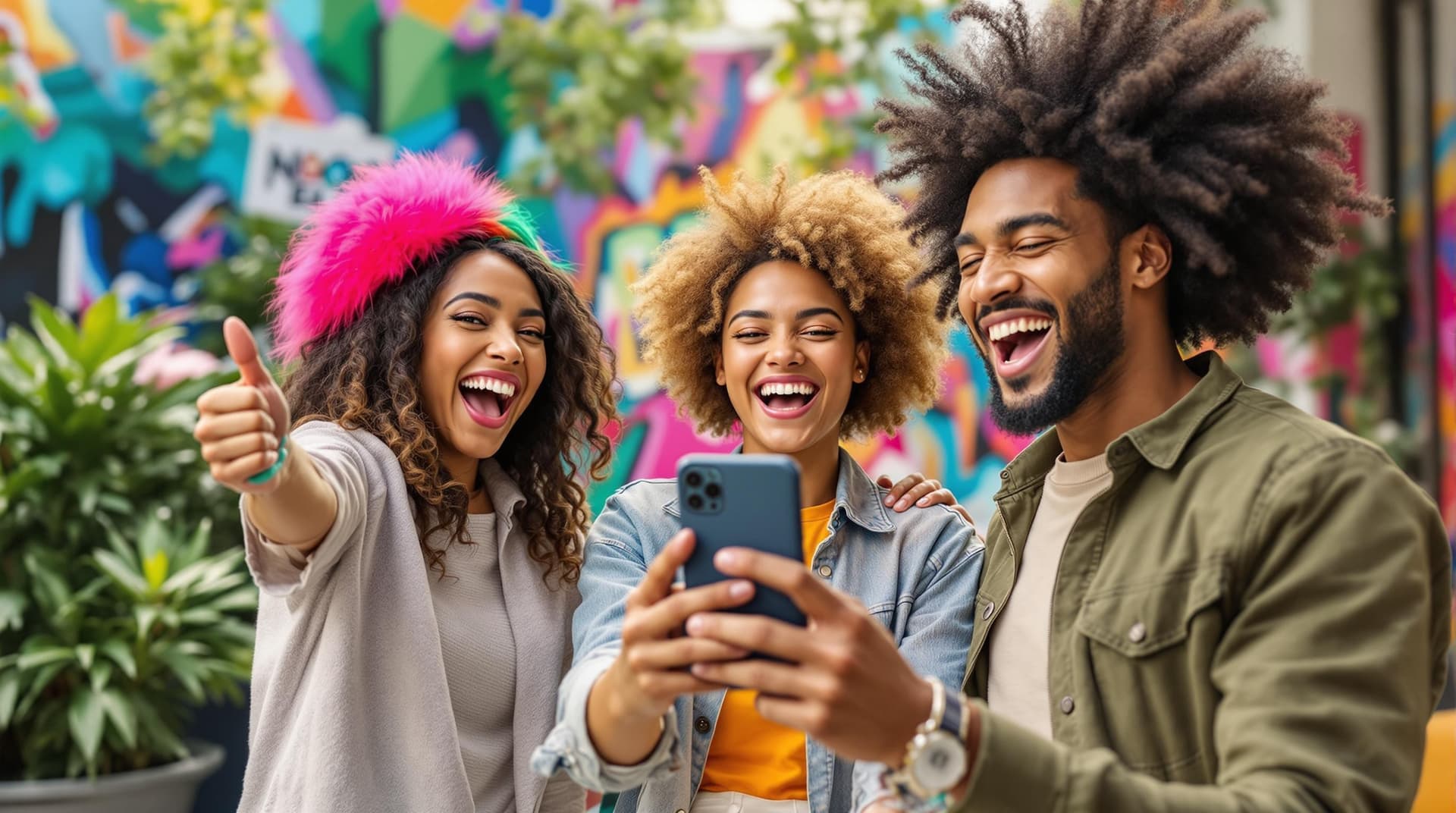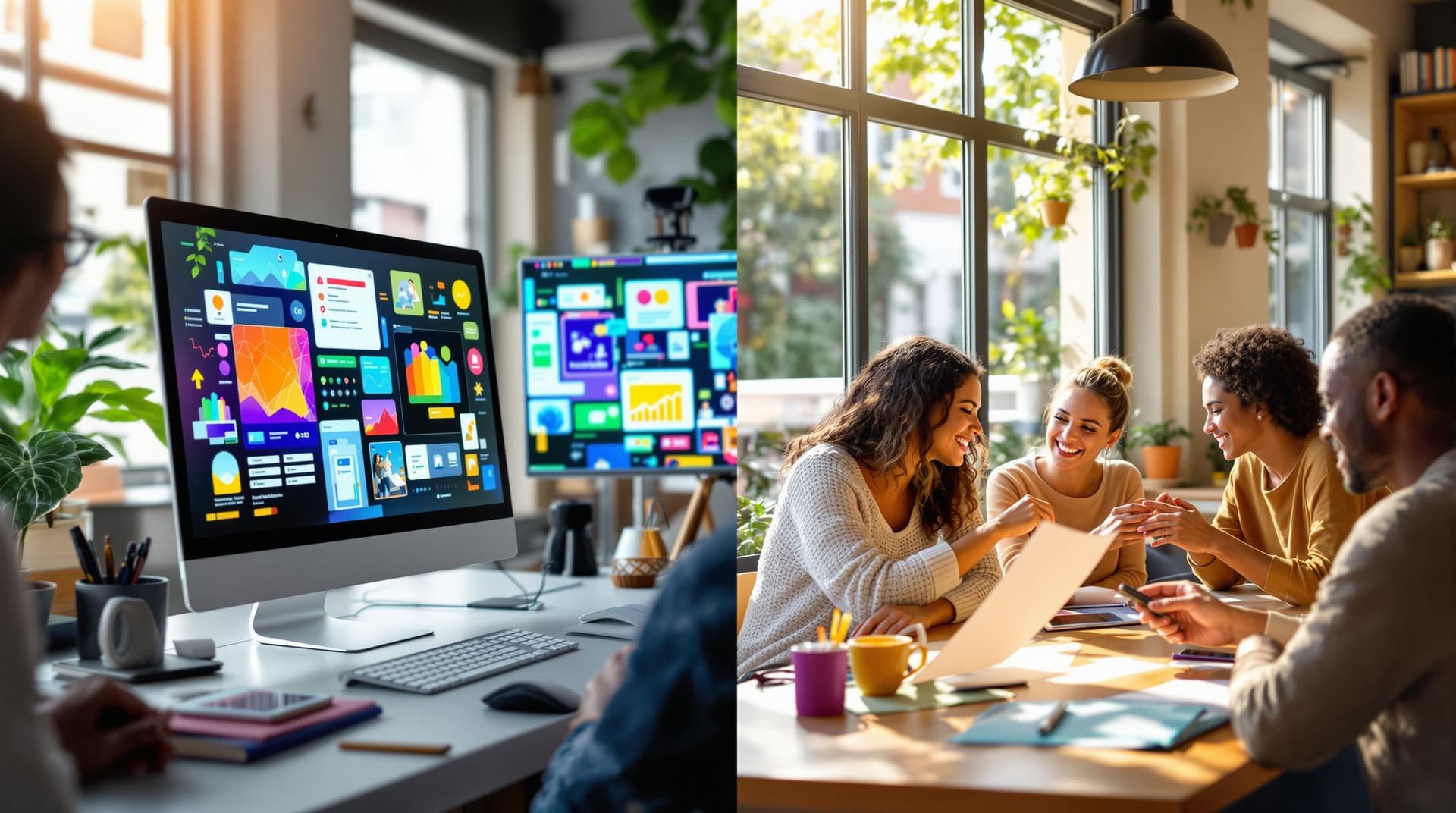
AI UGC (AI-driven user-generated content) is transforming video marketing by combining automation with a personal touch. Here's why it matters:
- 63% of marketers use AI-generated content, leading to 27% higher engagement and 35% more conversions.
- Brands can produce 500 videos in 20 languages weekly, cutting costs by 30% and boosting click-through rates by 42%.
- Tools like MagicUGC and Arcads.ai make it easier to create relatable, localized, and high-performing content.
Key Takeaways:
- Use natural language, relatable visuals, and conversational tones to make AI content feel authentic.
- Always disclose AI usage to build trust and comply with regulations.
- Leverage tools like MagicUGC for scalable, optimized content creation.
Ready to dive deeper? Learn about the best tools, strategies, and tips for creating effective AI UGC in the full guide.
How to Create Viral UGC Ads Using AI
Core Guidelines for AI UGC Creation
Balancing automation with a human touch is key to making AI-generated UGC work. Studies reveal that 76% of consumers trust content from "average" people more than brand-created content . This makes it crucial to create content that feels genuine, even when using AI.
Making AI Content Feel Natural
To make AI-generated UGC resonate, it's all about scaling personalization while keeping it relatable. Here's how some top brands are doing it:
| Element | Best Practice | Impact |
|---|---|---|
| Script Style | Use contractions and everyday language | 28% higher engagement rates |
| Visual Design | Incorporate relatable settings with small flaws | Builds viewer trust |
| Voice Tone | Maintain natural pacing and conversational flow | Stronger audience connection |
Meeting Disclosure Requirements
Transparency is non-negotiable. It protects the trust advantage and ensures compliance with regulations. The FTC requires clear AI disclosures, and platforms like TikTok have specific rules.
-
Platform-Specific Requirements
Platforms such as TikTok demand explicit labels like "AI-generated" in descriptions and on-screen text . -
Disclosure Best Practices
- Highlight AI use in content descriptions.
- Use straightforward phrases like "Created with AI" or "AI-generated content."
- Stay consistent across all platforms.
-
Legal Compliance
Data shows 54% of consumers find AI-generated content useful, but 71% want it clearly labeled . Always include:- Clear AI attribution.
- Honest product claims.
- Transparent commercial intent.
Transparent labeling doesn’t just meet legal standards - it also boosts credibility. This becomes even more important when optimizing content performance through testing, as we'll discuss in the next section.
AI UGC Tools and Platform Guide
After setting clear content guidelines, choosing the right tools is the next step. The best platforms blend AI-driven efficiency with a human touch while staying compliant with regulations.
AI-powered UGC tools have come a long way, offering advanced features that help brands produce realistic content while cutting production costs by up to 60% . Below, we’ll explore some of the leading platforms and what they bring to the table.
AI UGC Platform Comparison
Finding the right AI UGC platform means understanding how each one fits your specific marketing goals. Here's a breakdown of some top options:
| Platform | Key Features | Best Use Case | Starting Price |
|---|---|---|---|
| MagicUGC | • 98% accurate trend prediction • Multi-language support • Brand DNA Scanner |
Carousel ads & viral content | $149/month |
| Arcads.ai | • 300+ AI avatars • API automation • E-commerce integration |
Localized ad variations | $100/month (50 credits) |
| Social Clone | • 85% avatar accuracy • Lifelike digital twins • Custom voice generation |
Testimonial videos | $19/video |
| Poolday.ai | • Scalable production • Story-optimized content • Quick turnaround |
Instagram Stories | $10-15/video |
MagicUGC Platform Overview

MagicUGC is a standout platform for creating scalable user-generated content. It uses advanced machine learning models to analyze over a million social media videos, producing content tailored for Instagram and TikTok.
Key Platform Benefits:
- Advanced AI Technology: MagicUGC’s machine learning analyzes high-performing social media videos to create content that aligns with audience preferences, especially for Instagram and TikTok campaigns.
- Performance Optimization: With MagicUGC Boost™, content is automatically optimized in real time, increasing conversions by 45% .
Integration Capabilities: The platform integrates effortlessly with major e-commerce and social media channels, making it easier to manage campaigns across multiple platforms.
sbb-itb-d822133
How to Improve AI UGC Performance
Once you've picked your AI UGC platform, the next step is making sure your content delivers results. The key? Smart strategies that keep the user-generated content vibe intact while scaling up production.
Creating Strong Video Openings
The first three seconds of your AI UGC video are crucial. Platforms like TikTok, Instagram, and YouTube prioritize content that grabs attention right away and keeps viewers watching .
Here’s how to nail those openings:
- Attention-Grabbing Hooks: Use surprising visuals or bold statements to stop the scroll.
- Tailored for Each Platform:
| Platform | Best Opening Approach |
|---|---|
| TikTok | Hook + Problem Statement with top-screen text overlay |
| Instagram Reels | Bold visuals + Motion with brand colors upfront |
| YouTube Shorts | Start with a question + Clear value in 3 seconds |
- Mobile-Friendly Design: Place key text in the top third of the screen, where it’s easiest to read on mobile.
Once you’ve hooked viewers, the next step is keeping them engaged - and that’s where data comes in.
Using Data to Test and Improve Content
Data is your best friend when it comes to improving AI UGC campaigns. Here’s how to use it effectively:
-
A/B Testing: Experiment with different variations of:
- Opening hooks
- Call-to-action placements
- Backgrounds and lighting setups
-
Key Metrics to Watch:
- View Duration: Aim for over 60% completion.
- Engagement Rate: Compare against platform averages.
- Click-Through Rate: Crucial for action-driven content.
- Conversion Rate: Focused on sales-oriented videos.
- Real-Time Tweaks: Use performance data to fine-tune elements like visuals, text, and pacing.
-
Tailored Content for Your Audience:
- Adjust speech and visuals to fit cultural norms.
- Update references and examples for relevance.
- Use language and phrases that resonate with your audience.
What's Next for AI UGC
Technology is reshaping how brands create and share content. Here are some key trends set to influence video marketing strategies in the near future.
AI Voice Tools for Reaching Global Audiences
AI voice technology is making it easier for brands to connect with audiences worldwide by breaking language barriers. Tools like DeepMind's WaveNet and Resemble AI provide natural-sounding voice generation in over 50 languages .
These tools go beyond just translation. They incorporate localized accents and speech patterns, making content feel more relatable. For instance, a beauty brand using such technology saw a 25% increase in localized cart additions . To stay competitive, marketers should look for platforms that offer multilingual voice cloning.
While voice tech helps expand reach, predictive analytics takes targeting to the next level.
Predicting Content Success with Data
Predictive models are now capable of forecasting content performance before it even goes live. Tools like Pattern89's AI system boast up to 95% accuracy in predicting how content will perform . This is done by analyzing factors such as:
- Audience behavior
- Optimal timing
- Popular content formats
The results speak for themselves. A leading fashion retailer used predictive analytics to achieve a 40% jump in engagement rates and a 15% increase in sales driven by social media .
Personalization Through AI-Powered UGC
AI is also enhancing user-generated content (UGC) by integrating text, images, and videos into personalized campaigns. For example, Coca-Cola's AR campaign allowed users to create 100,000 unique designs in just one month, boosting engagement by 15%. AR filters keep the authentic feel of UGC while allowing brands to guide the creative process.
Looking ahead, AI tools will focus on creating hyper-personalized content at scale. These systems are expected to cut production time by 70% while maintaining brand consistency . To stay ahead, marketers need to adjust their strategies to embrace these advancements.
Conclusion: Getting Started with AI UGC
As AI-generated user content (AI UGC) continues to grow, moving from features like predictive analytics to voice localization, making it work effectively involves a few essential steps:
- Start with platform-specific pilot tests to see what resonates.
- Select tools that offer a good balance between cost and customization.
- Be transparent about using AI and manually refine outputs to maintain quality.
To measure success, tie your metrics directly to campaign goals. Here's a helpful breakdown:
| Metric Category | Key Indicators |
|---|---|
| Engagement | Views, likes, shares |
| Conversion | Click-through rate, sales |
| Efficiency | Time spent creating content |
| Cost | Production costs |
When crafting your first test content, revisit the platform-specific strategies outlined in Section 4. Use platform analytics regularly to tweak and improve your approach for better results across all channels.



